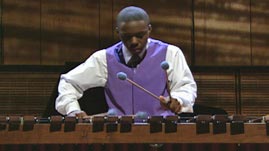Teachers' Domain - Digital Media for the Classroom and Professional Development
User: Preview


Source: From the Top at Carnegie Hall: "Rhythm and Strings"
You can see the full episode and a more complete lesson plan at the From the Top at Carnegie Hall Web site.



Exclusive corporate funding provided by Liberty Mutual. Additional funding provided by the Bernard Osher Foundation, the Jack Kent Cooke Foundation, the National Endowment for the Arts, Helen and Peter Bing, and the E.H.A. Foundation.
In this performance video segment from From the Top at Carnegie Hall, Joshua Jones plays "Rhythm Song" on the marimba. Listen for the different rhythms in the piece.
In the supplemental video segment, visit 16-year-old Joshua Jones at home in Chicago where he describes his love for percussion and the marimba. Whether he's accompanying the gospel choir in his church or playing with the Chicago Symphony Orchestra's Percussion Scholarship Group, Joshua hears rhythms all around him.
Found Sound: Joshua Jones Profile (Video)
The marimba is a cousin of the xylophone and the vibraphone, belonging to a class of instruments known as ideophones. This class of instrument produces sound by vibrating the body or substance of the instrument itself. The word ideophone comes from two Greek roots, one (ideo) meaning "self" and the other (phono) meaning "sound." Other classes of instruments are membranophones, chordophones, and aerophones. Aerophones use air to produce sound, chordophones use strings, and membranophones use membranes (such as drum heads). A clarinet is one example of an aerophone, a guitar is a type of chordophone, and a snare drum is a type of membranophone.
The marimba originated in Africa where many variations—based on local custom, materials, and culture—are still found. Folk marimbas might be made of wood, metal, plastic, gourds, or even bottles. Modern orchestral marimbas were first manufactured in the U.S. in 1910, and were popular in vaudeville shows. Serious composers did not generally write for them until after World War II.
Here is what composer Paul Smadbeck says about writing "Rhythm Song":1
"Rhythm Song" was originally written as a marimba solo and is quite effective when performed as such. However, during the latter stages of composition I found that the contrasting parts were brought out more keenly and the overall impact was increased when the work was performed simultaneously by two players; one playing as written and the other an octave higher.
As for style, I drew upon elements of minimalism, American jazz/fusion, and African music. The best way I can describe my overall intentions is to instruct the player to imagine that the selected notes of the marimba are pitched drums and his/her mission is to perform a drum solo as one would on a traditional drum set. As such, the melodic and harmonic elements are subservient to the rhythmic contrapuntalism. This was, in fact, the whole point of the piece in the first place—I consciously tried to make the melody and harmony so simple as to form a canvas on which the rhythmic interplay could be developed and explored.
In the first section of the piece (prior to 6/8 time) the pulse should be driven ahead solidly and relentlessly with no fluctuation in tempo. Some jazz/fusion players would refer to this as "putting it in the pocket"—it should have a "groove". In the 6/8 section, the feel is decidedly African; smoothly, in two, but again, no fluctuation in the pulse.
1 "Rhythm Song" performance notes as contributed to www.davesabine.com. Reprinted courtesy of Paul Smadbeck.
National Music Standards: Content Standard 7: Evaluating music and music performances
 Loading Standards
Loading Standards